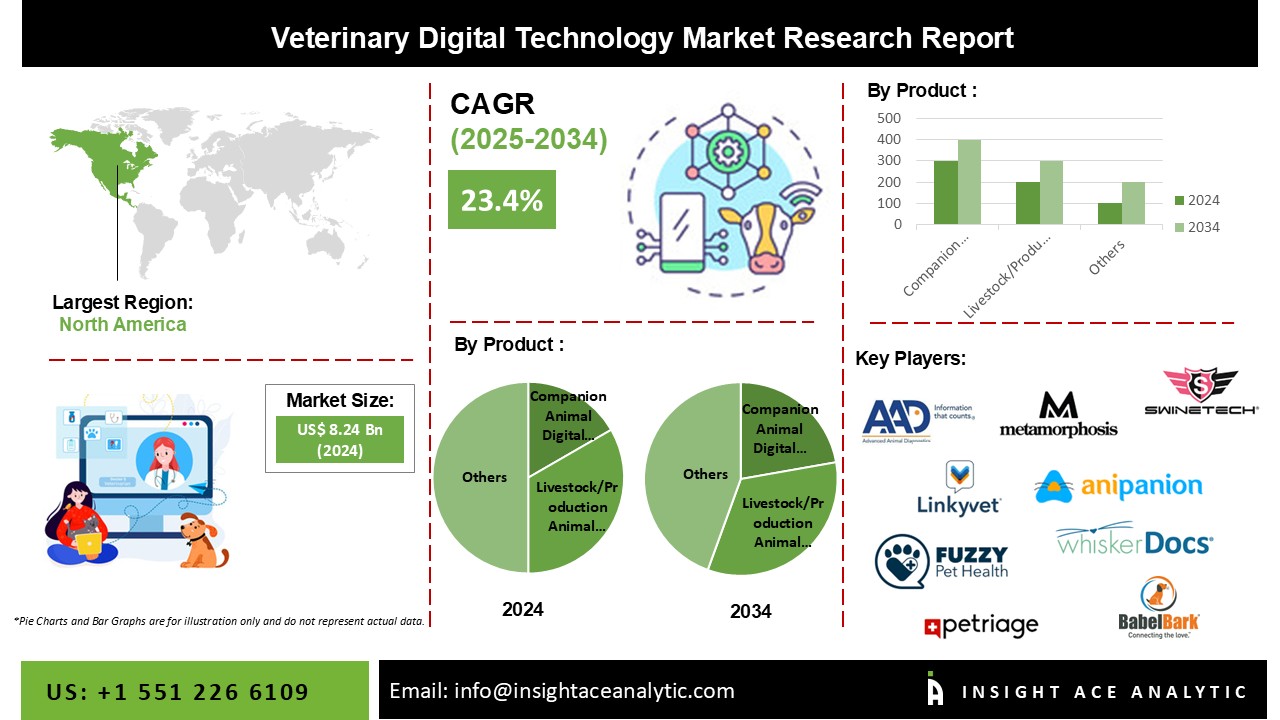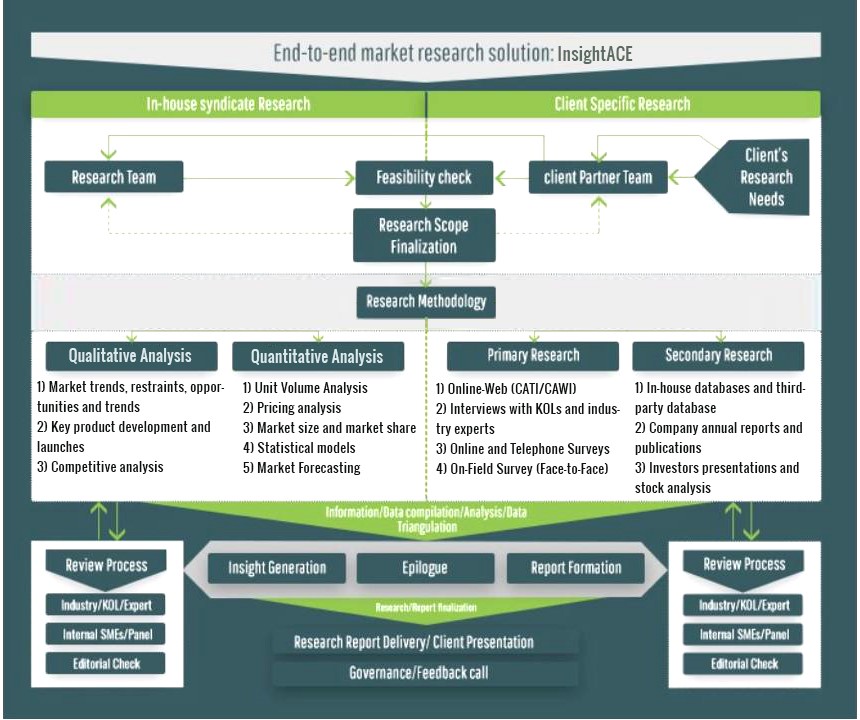Veterinary Digital Technology Market Size is valued at USD 8.24 Mn in 2024 and is predicted to reach USD 66.35 Mn by the year 2034 at an 23.4% CAGR during the forecast period for 2025-2034.

The rapid development of digital technology, in past few years, allowed a revolution in overall veterinary industry, including development of Telemedicine, Telehealth, monitoring devices, digital cameras and animal production field’s involvement. Digital technology in the veterinary industry offers a comprehensive system for different types of care settings along with custom features such as tracking and identification, behavior monitoring, and veterinary diagnosis. In the veterinary industry, technological improvement continues to develop the level of care, affordability and accessibility have allowed more widespread integration into smaller practices, including diagnostic imaging.
The growth is driven by the increasing application of Veterinary Digital Technology in growing animal health expenditure along with a rising number of veterinary practitioners in developed regions and development in the companion animal sector. Rapidly increasing demand for ensuring animal safety, security & medical diagnosis, and treatment in livestock is further likely to boost the market growth. Integration of digital technology is also projected to have a momentous impact on the animal healthcare industry during the forecast period. The market is growing rapidly, driven by the rising application of Veterinary digital technology in tracking and identifying, monitoring behavior, diagnosing medical concerns.
The Global Veterinary Digital Technology market is categorized on the basis of product, end-user, and region. On the basis of product type, the market is segmented into Companion Animal Digital Technology and Livestock/Production Animal Digital Technology. Companion Animal Digital Technology is further categorized into Telemedicine, Telehealth, reminder applications, trackers, wearables, and platform marketplaces. Livestock/Production Animal Digital Technology is further categorized into monitoring devices, identification devices, trackers, wearables, remote sensors, digital cameras, microphones, and environmental sensors. Based on region, the market is studied across North America, Asia-Pacific, Europe, and LAMEA. Among all, North America is expected to dominate the market during the analysis of the forecast period.
|
Report Attribute |
Specifications |
|
Market Size Value In 2024 |
USD 8.24 Bn |
|
Revenue Forecast In 2034 |
USD 66.35 Bn |
|
Growth Rate CAGR |
CAGR of 23.4% from 2025 to 2034 |
|
Quantitative Units |
Representation of revenue in US$ Million and CAGR from 2025 to 2034 |
|
Historic Year |
2021 to 2024 |
|
Forecast Year |
2025-2034 |
|
Report Coverage |
The forecast of revenue, the position of the company, the competitive market structure, growth prospects, and trends |
|
Segments Covered |
By Product |
|
Regional Scope |
North America; Europe; Asia Pacific; Latin America; Middle East & Africa |
|
Country Scope |
U.S.; Canada; U.K.; Germany; China; India; Japan; Brazil; Mexico; France; Italy; Spain; South Korea; South East Asia |
|
Competitive Landscape |
Metamorphosis Partners, Advanced Animal Diagnostics, Inc., Babel Bark, Inc., SwineTech, Inc., inulogica, whiskerDocs, LLC, Fuzzy Pet Health, Quantified Ag, Pathway Vet Alliance, Anipanion, Linkyvet, TeleVet, Petriage, Inc., TeleTails, VetNOW, Airvet, Pawz Limited, Oncura Partners, PetPro Connect, VETOCLOCK, and VetCT., and others |
|
Customization Scope |
Free customization report with the procurement of the report, Modifications to the regional and segment scope. Particular Geographic competitive landscape. |
|
Pricing and Available Payment Methods |
Explore pricing alternatives that are customized to your particular study requirements. |
Chapter 1. Methodology and Scope
1.1. Research Methodology
1.2. Research Scope & Assumptions
Chapter 2. Executive Summary
Chapter 3. Global Veterinary Digital Technology Market Snapshot
Chapter 4. Global Veterinary Digital Technology Market Variables, Trends & Scope
4.1. Market Segmentation & Scope
4.2. Drivers
4.3. Challenges
4.4. Trends
4.5. Penetration & Growth Prospect Mapping
4.6. Major Funding/Investment in Veterinary Industry
4.7. Industry Analysis – Porter’s Five Forces Analysis
4.8. Competitive Landscape & Market Share Analysis
4.9. Technology Advancement in Veterinary Digital Technology
4.10. Key Trends in the Market
4.11. Covid-19 Impact on Veterinary Industry
Chapter 5. Market Segmentation 1: Produt Estimates & Trend Analysis
5.1. Service Type & Market Share, 2024 & 2034
5.2. Market Size (Value US$ Mn) & Forecasts and Trend Analyses, 2021 to 2034 for the following Product:
5.2.1. Companion Animal Digital Technology
5.2.1.1. Telemedicine
5.2.1.2. Telehealth
5.2.1.3. Reminder Applications
5.2.1.4. Trackers
5.2.1.5. Wearables
5.2.1.6. Platform Market Places
5.2.2. Livestock/Production Animal Digital Technology
5.2.2.1. Monitoring Devices
5.2.2.2. Identification Devices
5.2.2.3. Trackers
5.2.2.4. Wearables
5.2.2.5. Remote Sensors
5.2.2.6. Digital Cameras
5.2.2.7. Microphones
5.2.2.8. Environmental Sensors
Chapter 6. Veterinary Digital Technology Market Segmentation 2: Regional Estimates & Trend Analysis
6.1. North America
6.1.1. North America Veterinary Digital Technology Market revenue (US$ Million) estimates and forecasts by Product, 2021-2034
6.1.2. North America Veterinary Digital Technology Market revenue (US$ Million) estimates and forecasts by country, 2021-2034
6.1.2.1. U.S.
6.1.2.2. Canada
6.2. Europe
6.2.1. Europe Veterinary Digital Technology Market revenue (US$ Million) by Product, 2021-2034
6.2.2. Europe Veterinary Digital Technology Market revenue (US$ Million) by country, 2021-2034
6.2.2.1. Germany
6.2.2.2. Poland
6.2.2.3. France
6.2.2.4. Italy
6.2.2.5. Spain
6.2.2.6. UK
6.2.2.7. Rest of Europe
6.3. Asia Pacific
6.3.1. Asia Pacific Veterinary Digital Technology Market revenue (US$ Million) by Product, 2021-2034
6.3.2. Asia Pacific Veterinary Digital Technology Market revenue (US$ Million) by country, 2021-2034
6.3.2.1. China
6.3.2.2. India
6.3.2.3. Japan
6.3.2.4. Australia
6.3.2.5. Rest of Asia Pacific
6.4. Latin America
6.4.1. Latin America Veterinary Digital Technology Market revenue (US$ Million) by Product, (US$ Million) 2021-2034
6.4.2. Latin America Veterinary Digital Technology Market revenue (US$ Million) by country, (US$ Million) 2021-2034
6.4.2.1. Brazil
6.4.2.2. Rest of Latin America
6.5. MEA
6.5.1. MEA revenue Veterinary Digital Technology Market revenue (US$ Million) by Product (US$ Million) 2021-2034
6.5.2. MEA revenue Veterinary Digital Technology Market revenue (US$ Million) by country, (US$ Million) 2021-2034
6.5.2.1. South Africa
6.5.2.2. Rest of MEA
Chapter 7. Competitive Landscape
7.1. Major Mergers and Acquisitions/Strategic Alliances
7.2. Company Profiles
7.2.1. Metamorphosis Partners
7.2.1.1. Business Overview
7.2.1.2. Key Product/Service
7.2.1.3. Financial Performance
7.2.1.4. Geographical Presence
7.2.1.5. Recent Developments with Business Strategy
7.2.2. Advanced Animal Diagnostics, Inc.
7.2.3. Babel Bark, Inc.
7.2.4. SwineTech, Inc.
7.2.5. inulogica
7.2.6. whiskerDocs, LLC
7.2.7. Quantified Ag (Merck & Co., Inc.)
7.2.8. Pathway Vet Alliance (TSG Consumer)
7.2.9. Anipanion
7.2.10. Linkyvet
7.2.11. Otto
7.2.12. Petriage, Inc.
7.2.13. TeleTails
7.2.14. VetNOW
7.2.15. Airvet
7.2.16. Pawz Limited
7.2.17. Oncura Partners (Analogic)
7.2.18. BI X GmbH (Boehringer Ingelheim company)
7.2.19. VETOCLOCK
7.2.20. VetCT
7.2.21. Vetster, Inc.
7.2.22. Smartbow (Zoetis Services LLC.)
7.2.23. IDEXX Laboratories, Inc.
7.2.24. Vetspire, LLC
7.2.25. Hippo Manager
7.2.26. Covetrus
7.2.27. VitusVet
7.2.28. Healthy Pet Connect
7.2.29. Mella Pet Care
7.2.30. Shepherd Veterinary Software
7.2.31. Animal Intelligence Software
7.2.32. VetRadar
7.2.33. VetSnap Corporation
7.2.34. VETport LLC.
7.2.35. Vetstoria
7.2.36. Other Prominent Players
Global Veterinary Digital Technology Market Based on Product
Global Veterinary Digital Technology Market Based on Region
Europe Veterinary Digital Technology Market by Country
North America Veterinary Digital Technology Market by Country
Asia Pacific Veterinary Digital Technology Market by Country
Latin America Veterinary Digital Technology Market by Country
Middle East & Africa Veterinary Digital Technology Market by Country
InsightAce Analytic follows a standard and comprehensive market research methodology focused on offering the most accurate and precise market insights. The methods followed for all our market research studies include three significant steps – primary research, secondary research, and data modeling and analysis - to derive the current market size and forecast it over the forecast period. In this study, these three steps were used iteratively to generate valid data points (minimum deviation), which were cross-validated through multiple approaches mentioned below in the data modeling section.
Through secondary research methods, information on the market under study, its peer, and the parent market was collected. This information was then entered into data models. The resulted data points and insights were then validated by primary participants.
Based on additional insights from these primary participants, more directional efforts were put into doing secondary research and optimize data models. This process was repeated till all data models used in the study produced similar results (with minimum deviation). This way, this iterative process was able to generate the most accurate market numbers and qualitative insights.

Secondary research
The secondary research sources that are typically mentioned to include, but are not limited to:
The paid sources for secondary research like Factiva, OneSource, Hoovers, and Statista
Primary Research:
Primary research involves telephonic interviews, e-mail interactions, as well as face-to-face interviews for each market, category, segment, and subsegment across geographies
The contributors who typically take part in such a course include, but are not limited to:
Data Modeling and Analysis:
In the iterative process (mentioned above), data models received inputs from primary as well as secondary sources. But analysts working on these models were the key. They used their extensive knowledge and experience about industry and topic to make changes and fine-tuning these models as per the product/service under study.
The standard data models used while studying this market were the top-down and bottom-up approaches and the company shares analysis model. However, other methods were also used along with these – which were specific to the industry and product/service under study.
To know more about the research methodology used for this study, kindly contact us/click here.